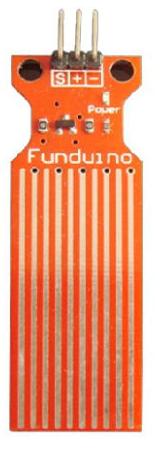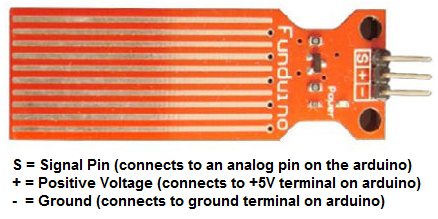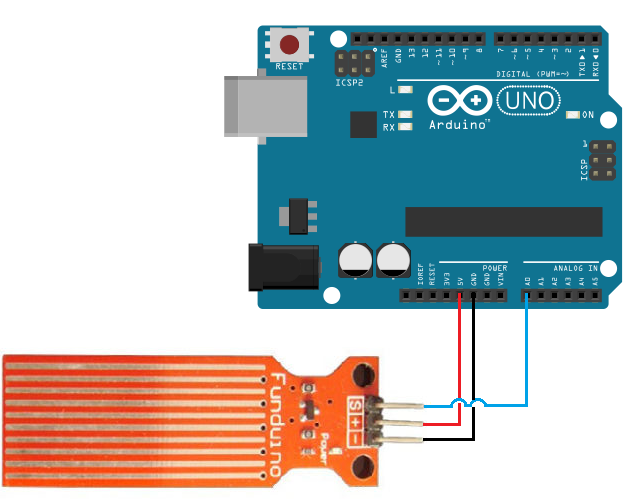How to Build a Liquid Level Sensor Circuit with an Arduino

In this project, we will build a liquid level sensor circuit with an arduino.
This circuit will be able to tell us roughly how much of the sensor is covered by liquid.
Liquid level sensors are used for all types of applications. They are extensively used within automobiles, which rely on a substantial amount of different fluids in order to operate to check for how much gas in the car, windshield washer fluid, oil levles. Basically, they are used whenever we want to measure the level of any type of fluid of a system. Thus, they are extremely valuable to be able to learn and manipulate and build circuits with.
The liquid level sensor we will use is an analog sensor, meaning it outputs an analog voltage in proportion to the amount of liquid the sensor is exposed to. We just connect the analog pin, represented by an S, to an analog pin on the arduino board to read the analog value.
As you can see from the above image, the sensor has a series of parallel wires across the board. These wires are what sense the liquid level that the board is exposed to.
If the board has water or another fluid covering all the wire, then it will output a maximum analog value reading. Since analog values read by an arduino range from 0 (lowest reading) to 1023 (highest reading), a board completely submerged with a liquid will have a reading of 1023 by an arduino. If the board is halfway covered, a reading of about 512 will be read by the arduino. If the board is 1/4 covered by a liquid, then the arduino will read about 256. And if no liquid is on it at all, then a near 0 reading should be obtained.
With our liquid level sensor and an arduino, there are a number of options of what we can do. We can use the sensor, simply, to read and output the analog value obtained. Or we can create a type of alarm indicator status system. For example, we can have a green LED light up when the sensor is completely full (submerged to the top with fluid), indicating that it's full. We can have a red LED light up when the sensor's liquid level falls below 1/4 level, like how car dashboard LED indicators tell us when our gas tank goes below E (empty).
So with a microcontroller like the arduino, there are basically limitless options of how we can incorporate the liquid level sensor.
In this circuit, we will build now, we will just do the most basic circuit and simply read and output
the analog value
read by the arduino.
Components Needed
- Arduino
- Liquid Level Sensor
The liquid level sensor we will use is built by China Harbin Okumatsu Robot Technology Co and its product item is RB-02S048. This part can easily be obtained on ebay for most of the time under $2 including shipping. It's very inexpensive.
The sensor operates on 5V and needs less than 20mA for operating power current, which means the arduino can easily provide this (so no external power is needed to power it).
The liquid level sensor has 3 pins. It's very basic. The pinout is shown below.

2 of the pins are for power, 1 connecting to the +5V of the arduino and the other connecting to the ground
terminal of the arduino.
The other pin, with an S, is the signal pin. This is the pin that outputs the analog voltage signal in proportion
to the amount of
the sensor which is covered with liquid. This pin connects to an analog pin on the arduino board to be read.
Arduino Liquid Level Sensor Circuit
The schematic diagram of the arduino liquid level sensor circuit is shown below.

This circuit is as basic as it can get.
The liquid level sensor board needs about 5V of power.
The signal pin (S) gets connected to an analog pin on the arduino board. Here we connect it to analog pin A0.
This allows the arduino board to be able to read the analog voltage value.
Code
With the hardware setup, all we need now is the code to obtain the sensor reading.
const int sensorPin= 0;
int liquid_level;
void setup() {
Serial.begin(9600);
pinMode(sensorPin, INPUT);
}
void loop() {
liquid_level= analogRead(sensorPin);
Serial.println(liquid_level);
delay(100);
}
In the first block of code, we declare the sensorPin variable and initialize it to 0. We then declare a liquid_level variable, which will hold the value of the analog value output from the sensor, serving as our sensor reading, which represents the liquid level.
In our setup() function, we set the baud rate and make the sensorPin input, since it is an input value into the arduino board to be read.
In our loop() function, which is the code that repeats over and over, we read the value from the sensorPin
and store it in the variable liquid_level. We then output this value to the Serial Monitor to be read. The code is constantly
running this code over and over, so it obtains new readings endlessly. We give a delay of 100ms in between each reading to
create a small pause in between.
Related Resources
How to Use the LM741 Op Amp as a Comparator
How to Build an LM339 Quad Voltage Comparator Circuit
How to Build a Dark-activated Switch
How to Build a Hall Effect Sensor Circuit
How to Build a Touch Sensor Circuit
How to Build an Accelerometer Circuit
How to Build a Motion Detector Circuit
How to Build a Motion Detector Alarm Circuit
